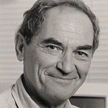In Focus: Dr. Harvey Karten
Who: Harvey Karten, M.D., Professor of Neurosciences
Where he works: The University of California, San Diego
Research focus: The evolution of the organization of avian brains.
MBF Bioscience software used: Neurolucida
Major scientific contributions: Neuroscientists use the bird brain model to better understand the organization and evolution of the human brain thanks to Dr. Karten’s research on nonmammalian vertebrates. In addition, Dr. Karten is a brain-mapping pioneer. He is a contributor to Brainmaps.org, an interactive brain atlas developed by Professor Edward Jones of UC Davis. Used by scientists around the world, BrainMaps.org features a database of extremely high-resolution images of the monkey, rat, bird, goldfish, and other vertebrate and invertebrate brains.
Elementary brain tracing: In the early days, Dr. Karten implemented a laborious process to reconstruct sections of the brain. The method used by scientists in the early 1960s involved macro projectors, hand tracing, and point to point matching aided by a microscope. “What you then tried to do in this somewhat enlarged drawing was to try to localize very small events. That’s very difficult to do. The difference in scale doesn’t allow for accurate localization,” he explained.
How Neurolucida helped: On a tip from Dr. Hendrick Vanderloos, who he heard speak about electronic applications of data collection in neuroanatomy, Dr. Karten started using transducers. “By using motorized stages with transducers on them, Neurolucida allows you to have a detecter on the stage that localizes axons and cells with a precision of better than one to two micrometers,” he said. “That’s an extremely powerful advance in tracing.”
Obtaining precise information at extremely high magnifications has always been the goal, explained Dr. Karten, who is often faced with the challenge of localizing objects that measure one micron in length in fields spanning upwards of 20,000 by 50,000 micrometers. “How do you accurately show that it’s in one specific position and not ten micrometers away from there? That is where the motorized stages and transducers came into such important play,” he explained. “Neurolucida allows very precise localization within the brain of the distribution of labeled cells and axons. That’s the critical thing. That was the strategy that was first developed by MBF Bioscience’s co-founder Ed Glaser back in 1961.”
Google Earth for the brain: A first hand witness and major player in the evolution of brain imaging, Dr. Karten says the most exciting period is the one we’re in right now. “Instead of trying to localize one axon at a time as you look at the actual slide, we can scan the whole slide with great accuracy, and generate a virtual Google Earth type of image of every single section of the brain,” he said.
Applications like Google Earth reveal new layers of images as you zoom in, Dr. Karten explained. The hidden layers feature higher levels of magnification, so the picture becomes more detailed the deeper you dig. “It’s like a giant pyramid,” he said. “The base of the pyramid has pictures that are so precise that you can see the chairs in your back yard. That is called pyramid viewing, and it’s the basis of much of the modern digital imaging that we now use in brain projects.”
Mapping the brain with Neurolucida: Dr. Karten uses Neurolucida to interpret these “Google Earth type images of the brain. He can now trace the entire outline of the brain in under a minute, a process that once took hours. “Neurolucida has the tools that allow us to trace the boundaries, to do all the things that involve mapping the information so that we can interpret it and make sense of it,” he said.
From his serial sections, he makes 3D models of the brain that he can “twist and rotate and turn back the layers the way you would turn back the quilt on a bed to see what’s underneath.”
“It’s multiple technologies all converging, and Neurolucida plays a big role in it—the technology to scan, to generate images, to look at the images, to extract the data,” he said.
One recent morning, Dr. Karten loaded BrainMaps.org on his computer. He clicked “Mus Musculus” and zoomed in on a section of the brain of the common house mouse. “This is astounding,” he exclaimed. “We might have been able to do this years ago, but collection of one such picture would have taken days or weeks. We do that whole section in less than one minute, and at a resolution of better than 0.5 micrometers/pixel. You can take a picture with that much detail in less than one minute. This is the future of neuroanatomy.”
“In Focus” is a series that spotlights scientists who use MBF Bioscience products in their work. Thank you, Dr. Harvey Karten for participating.
For the latest news about MBF Bioscience and our customers, fan us on Facebook and follow us on Twitter.
{image courtesy of UCSD Neurosciences Graduate Program}



